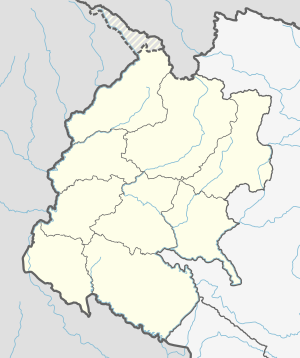Joshipur is Rural Municipality in Kailali District of Sudurpashchim Province established by merging Bauniya and Joshipur two existing village development committees.[1] Joshipur lies 75 km east of Dhangadhi and 61 3 km west of the capital, Kathmandu. It is surrounded by Lamki Chuha Municipality , Tikapur Municipality and Janaki Rural Municipality in the East , Ghodaghodi Municipality and Bhajani Municipality in the West , Bardagoriya Rural Municipality in the North and Bhajani Municipality in the South.
Joshipur Rural Municipality
जोशीपुर गाउँपालिका | |
|---|---|
| Coordinates: 28°34′03″N 81°00′53″E / 28.5674°N 81.0147°E | |
| Country | |
| Province | Sudurpashchim Province |
| District | Kailali District |
| Government | |
| • Chairman | Chitra Bahadur Chaudhary (NUP) |
| • Vice-Chairman | Rekha Devi Kathariya (NUP) |
| Area | |
| • Total | 65.6 km2 (25.3 sq mi) |
| Population (2011) | |
| • Total | 36,459 |
| • Density | 560/km2 (1,400/sq mi) |
| Time zone | UTC+5:45 (NST) |
| Post code | 10900 |
| Area code | 091 |
| Website | http://joshipurmun.gov.np |
Demographics edit
At the time of the 2011 Nepal census, Joshipur Rural Municipality had a population of 36,459. Of these, 79.4% spoke Tharu, 9.8% Doteli, 6.2% Nepali, 2.8% Achhami, 0.6% Maithili, 0.5% Hindi, 0.5% Urdu, 0.1% Newar and 0.1% other languages as their first language.[2]
In terms of ethnicity/caste, 80.2% were Tharu, 8.7% Chhetri, 2.9% Hill Brahmin, 2.4% Kami, 1.5% Damai/Dholi, 1.5% Thakuri, 1.0% Musalman, 0.6% other Dalit, 0.3% Sarki, 0.2% Newar, 0.1% Badi, 0.1% Kayastha, 0.1% Koiri/Kushwaha, 0.1% Magar, 0.1% Sonar, 0.1% Teli and 0.2% others.[3]
In terms of religion, 97.9% were Hindu, 1.0% Christian, 1.0% Muslim and 0.1% Buddhist.[4]
In terms of literacy, 60.3% could read and write, 2.6% could only read and 37.1% could neither read nor write.[5]
Temples edit
- Ram Janaki Mandir, Jabahi
- Shree Someswarnath Mandir, Badhariya
- Shree Baneshwar baba sibha Mandir Dham, Bani
See also edit
References edit
- ^ "Nepal Census 2001". Nepal's Village Development Committees. Digital Himalaya. Archived from the original on 12 October 2008. Retrieved 15 November 2009..
- ^ NepalMap Language [1]
- ^ NepalMap Caste [2]
- ^ NepalMap Religion [3]
- ^ NepalMap Literacy [4]
External links edit

